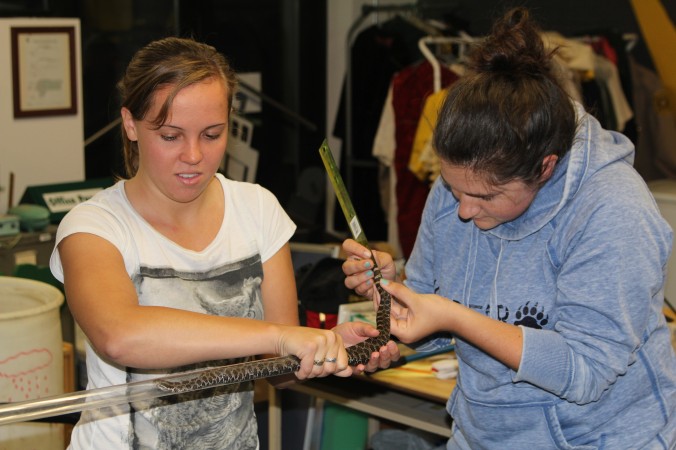We are pleased to welcome Rachael Hornsby to the blog this week. Rachael is an MSc student at Queen’s University working in a freshwater fisheries conservation lab. For our avid readers, Rachael is the Rachael featured in the previous post Julia and Rachael’s excellent Muskoka adventure. For more about Rachael, see the end of her post.
It was the hottest day yet of the summer. No clouds, no wind, just 35°C plus 80% humidity and 100% bugs. ALL OF THE BUGS. It was my first time truly out in the field during my undergrad and we were looking for seven species of snakes found near Parry Sound, Ontario. I had neglected to tell the Master’s students I was volunteering with that I was afraid of snakes… you know, I figured if I didn’t tell anyone then I couldn’t be afraid and I would get over it. Much to my surprise, it worked! I held my very first snake that day, a cute (yes, snakes are cute) little Northern Ring-necked snake. Even though I woke up the next day with my face so covered in bug bites my mom thought I had the mumps, it was the start of a new beginning.
After my volunteering experience, I landed a job with Ontario Parks as a snake species at risk student researcher, specifically working with the Eastern Massasauga Rattlesnake. I helped build snake fencing along park roads and hooked the fencing up to eco passages, responded to radio calls about the rattlesnakes that found their way onto campsites, conducted emergence and gestation surveys, and even pit tagged the rattlesnakes to keep track of the park population. I can tell you that there’s nothing like arriving to a campsite with a 40 year old man dancing on top of a picnic table, yelling “It’s under the Rubbermaid bin! It’s under the Rubbermaid bin!” while his wife laughs and comments that a 20-year-old girl is here to rescue him.
The park has a great set up, over 7 km of fencing lining roads and 4 eco passages equipped with pit tag readers and trail cams to see which snakes cross the road and when. One of my daily tasks was to walk the fences looking for damage and any rattlesnakes that found their way there. In a place where almost 6000 campers are camping at any given time, a girl walking with a hook and a pillowcase just inside the woods tends to attract quite a bit of attention. I met a lot of really interesting people, who had A LOT of questions, so I compiled some cool facts about the Eastern Massasauga Rattlesnake.

A female Eastern Massasauga Rattlesnake displaying unique back patterns
Did you know?
- They are Ontario’s only venomous species of snake (the Timber Rattlesnake is extirpated) and currently listed as ‘Threatened’ under the Ontario ESA and SARA
- They give live birth to 11-15 young
- 25% of the time an adult will give a ‘dry bite’ – a bite with no venom
- Although venomous, only 2 people in Ontario’s recorded history have ever died from a bite and they never sought medical treatment (you should always go to the hospital if bitten!)
- Like a fingerprint, each snake has a unique back pattern that can be used to identify it
- They have limited ranges. Moving one further than 1 km from its capture site might kill it because they use the same general hibernation sites year after year. If they can’t find this hibernation site they might not survive the winter.
I also had the opportunity to work on a project looking at whether Massasaugas can be relocated to new hibernation sites, in order to reduce the impact of a 4 lane highway expansion. This was one of my favourite field jobs;10+ hour days hiking through the woods tracking adult rattlesnakes equipped with radio transmitters. Several times I had to enter a graminoid marsh, vegetation up to my hips, with dead veg underneath, just strong enough to support a rattlesnake at knee level instead of ankle level. Your mind starts to wonder: I’m tracking 3 snakes in here… so how many untagged ones are nearby?

My Dad helping to coax a young Eastern Massasauga rattlesnake into the tube before processing

Jen Mills holding the rattlesnake in the tube while I measure its tail to determine sex

Pit tagging the rattlesnake for future ID and detection through eco passages
The most surreal experience happened one day while I was sitting eating lunch on a rock outcrop. I noticed some flagging tape running north through the adjacent trees. It turns out that where I was sitting was the future home of the two northbound highway lanes. To this day nothing compares to the feeling of sitting quiet in an undisturbed forest, knowing in a couple years it will be forever altered but that I had a hand in making a difference to the snakes that call it home.
It’s funny how things change. I started out being afraid but now after completing several years of fieldwork with the Eastern Massasauga, I long for the days that I watched my step and listened intently for the rattling sound of my legless friends in the woods.

Rachael holding a Gray Ratsnake
Rachael completed her Bachelor of Science at Queen’s University during which she spent her summers working with rattlesnakes in the Georgian Bay area. After graduating she spent a year working with snakes and honing her radio telemetry skills before returning to school. She is currently a masters student in the Freshwater Fisheries Conservation Lab at Queen’s University, using acoustic telemetry to study how competitive fishing tournaments affect black bass movements in Eastern Lake Ontario.
Pingback: Oh, the places we’ve gone and the places we’ll go | Dispatches from the Field